How To Use Cricut Stencil Vinyl
Virtually Cricut projects involve cutting images out of a some sort of material and placing them onto your project. But did y'all know you lot can likewise utilize your Cricut machine to make stencils? This involves cutting a design into stencil textile, painting over it, so removing the material to reveal a design permanently transferred to your project. It'southward so fun, and not at all hard to do; but there are some tips and tricks y'all need to know in order for your projects to turn out just correct. Today, I want to testify you how to cut stencils with a Cricut machine so you lot as well can swoop into this whole new earth of artistic possibilities!
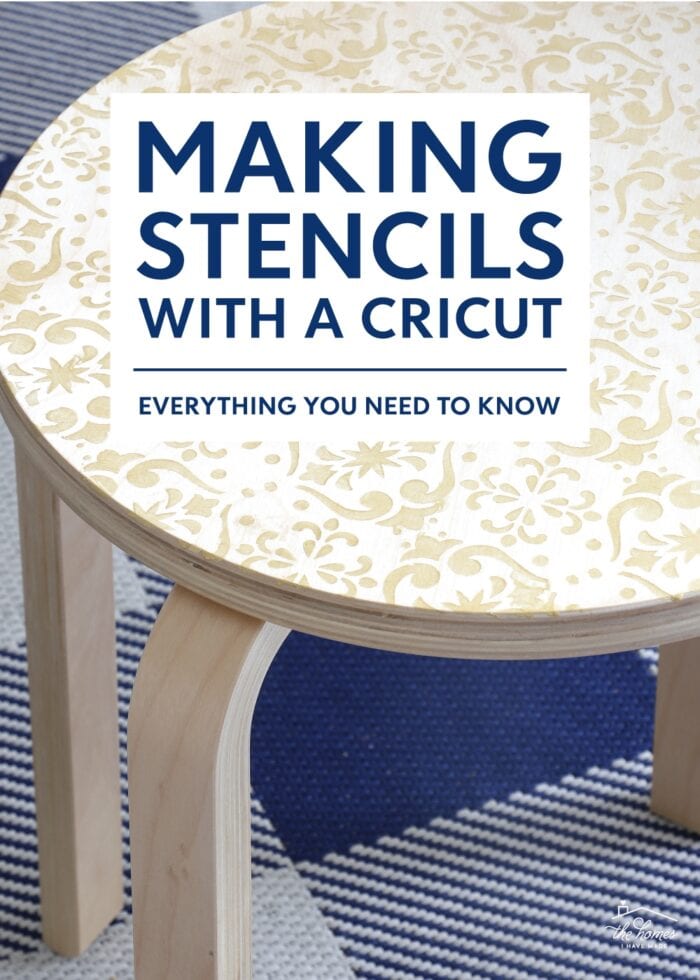
What are Stencils?
Stencils are essentially designs (e.g., shapes, patterns, words, phrases, etc) cut into plastic cloth that is then overlaid onto paintable/stainable surfaces such as wood, walls, cloth, etc. Paint or stain is practical over the stencil; and when the stencil is pulled away, the relief of the pattern (opposite) is revealed on the surface.
In the motion picture beneath, my hands are holding a small stencil of an abstract design. When placed on the wood, painted over and so removed, the blue design (shown to the right) is left behind.

Why Use Stencils?
These days, there are so many different ways to add together patterns to home decor items. Case in bespeak, I've used vinyl to make my own "wallpaper", furniture decals, and decorative tray; and fe-on to add together designs to a sign. So why get through the hassle of using a stencil (with messy paint or stain) to decorate an object?
Although adding designs with vinyl or fe-on is piece of cake and looks great, information technology's also very temporary (significant it tin can exist peeled off). Additionally, designs created with these adhesive-backed products volition take a raised surface, making them difficult to seal or waterproof.
On the other hand, stenciling a blueprint onto a surface makes the details permanent since paint/stain soaks into the wood rather than sit on tiptop. Therefor, the design will be harder to remove (you lot'll either demand to sand information technology off or pigment over it); and your surface will remain flat and smooth. Stenciled designs also take a more polished/professional appearance (especially when it comes to home decor) compared to details added via plastic-like vinyls.
Supplies Needed
Hither is what you volition need to make your ain stencil:
- Surface to Stencil – Walls or unfinished wooden objects work best. (This projection uses the IKEA FROSTA stool, which is discontinued in the US, but here is a similar version).
- Cricut Machine – Any Cricut machine tin be used for this project (Cricut Joy | Cricut Explore models | Cricut Maker models)
- Fine Point Bract – comes with your machine
- Standard Grip Cut Mat
- Weeding Tool
- Stencil Vinyl – More on this product below
- Scraper Tool or Brayer
- Pigment or Stain of your choice – Bones acrylic paint works crawly on unfinished wood surfaces, is upkeep-friendly, comes in every color imaginable, and is easy to use.
- Paint Castor, Stencil Brush, or Sponge Brush
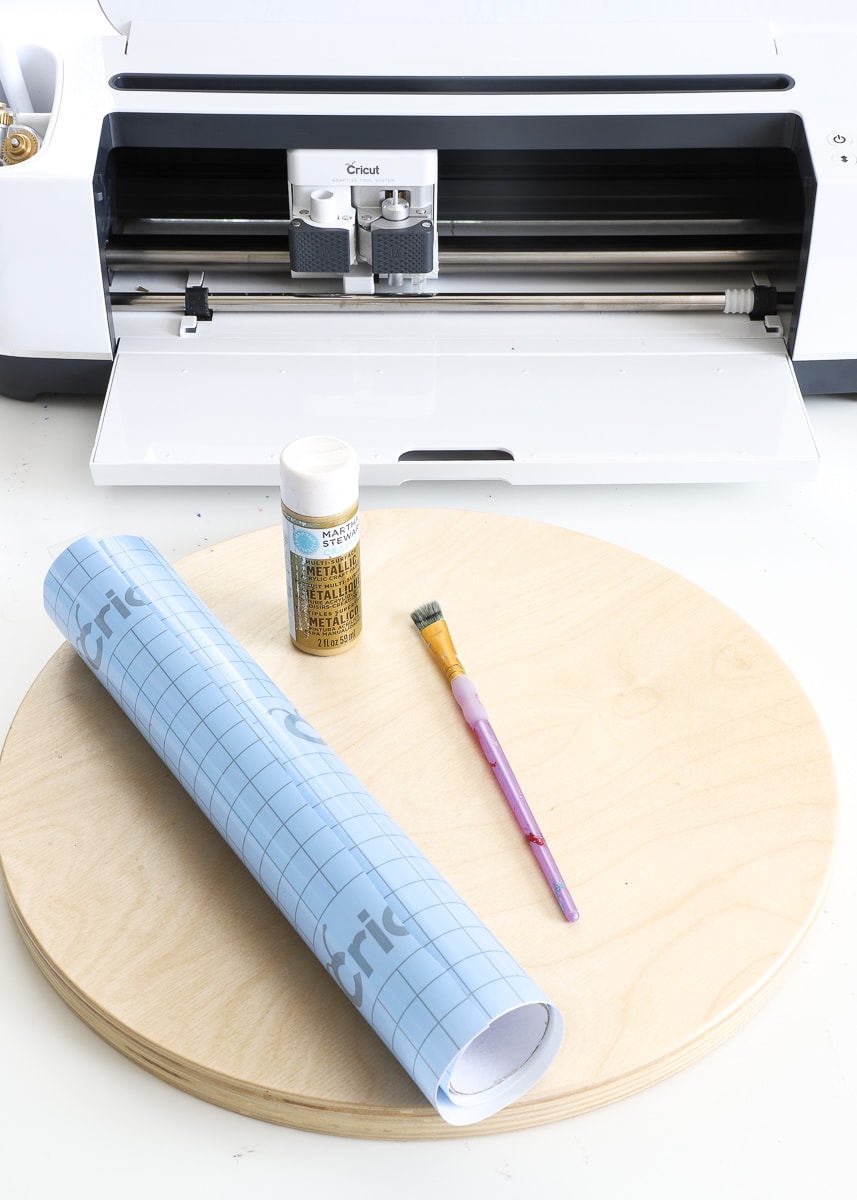
All Well-nigh Cricut's Stencil Vinyl
Mylar Sheets
For a long time, the only fashion to create reusable stencils was with mylar stencil sheets. Any design tin exist cut into these plastic sheets (either past hand or with a cutting automobile), merely they require stencil adhesive to concord them in place on your projection. And since it's usually hard to create a tight steal betwixt a surface and a thicker plastic sheet, these "traditional" stencils are decumbent to "haemorrhage" (i.east., pigment seeping under the edges), which results in dirty designs.
Removable Vinyls
Crafters so started turning to removable vinyl or freezer paper to create custom DIY stencils since these products tin can attach tightly to the base layers. Even so, both of these products are unmarried apply, every bit they don't pull off in ane slice without pregnant tearing or baloney. So while these products might be fine for a one-time application, they are not platonic for larger projects where you need to employ the same stencil over and over.
Stencil Vinyl
Stencil Vinyl, on the other paw, is stronger and thicker than your typical crafting vinyl. It cuts and weeds like vinyl, but it doesn't stretch or warp (which means you can pick it up over and over once more). Information technology'southward essentially the all-time of both worlds: an easy-to-cutting stencil that sticks firmly to your project but tin still be used multiple times.
This Cricut tutorial is going to detail instructions for making stencils with Stencil Vinyl; however, the same process applies no matter what stencil fabric yous choose!
Psssst – At the bottom of this post, I answer a bunch of FAQs related to Stencil Vinyl!
A Stencil Project From Starting time-to-Finish
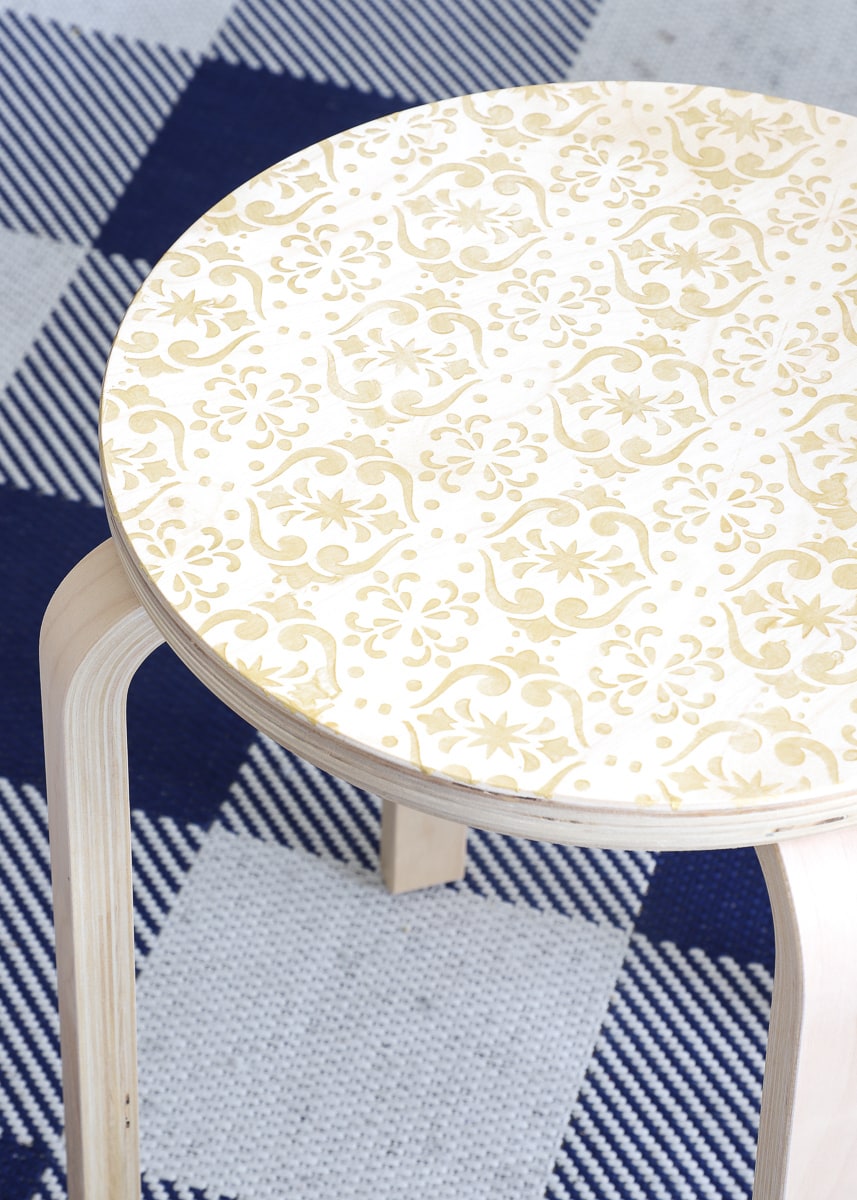
Step 1 – Design Your Stencil
Start by creating your stencil pattern in Cricut Blueprint Infinite. Every stencil design will depend on both the design itself and the size of your particular project. I share a agglomeration of pattern tips at the end of this mail service; however, no matter the size and telescopic of your stenciling projection, be sure you lot consider the following:
- The size of your overall project – Is your projection pocket-size enough that y'all can cut a single stencil to embrace the unabridged thing? Or will you demand to cutting a unmarried pattern apart (or create a repeatable pattern) to adjust a larger project?
- The scale of the pattern – If yous want your design modest and tight, you will probable demand to repeat the image over and once more and Weld it into a larger cut. If you lot want a larger-calibration design, you can expand a single pattern to fit a bigger surface area.
- How big yous tin cutting on your item Cricut car – You tin cut stencils upwards to eleven.five″ wide on both the Cricut Maker and Explore models, but you tin only cut 4.five″ broad on a Cricut Joy. This will influence how you cut your particular pattern.
As an instance: My stool measured about 14″, so I used the Slice Tool to cut my design (Floral Inlay Tile Square, #M23D2FB0) into 2 parts. One time cut and placed together side-past-side, the blueprint continues perfectly.
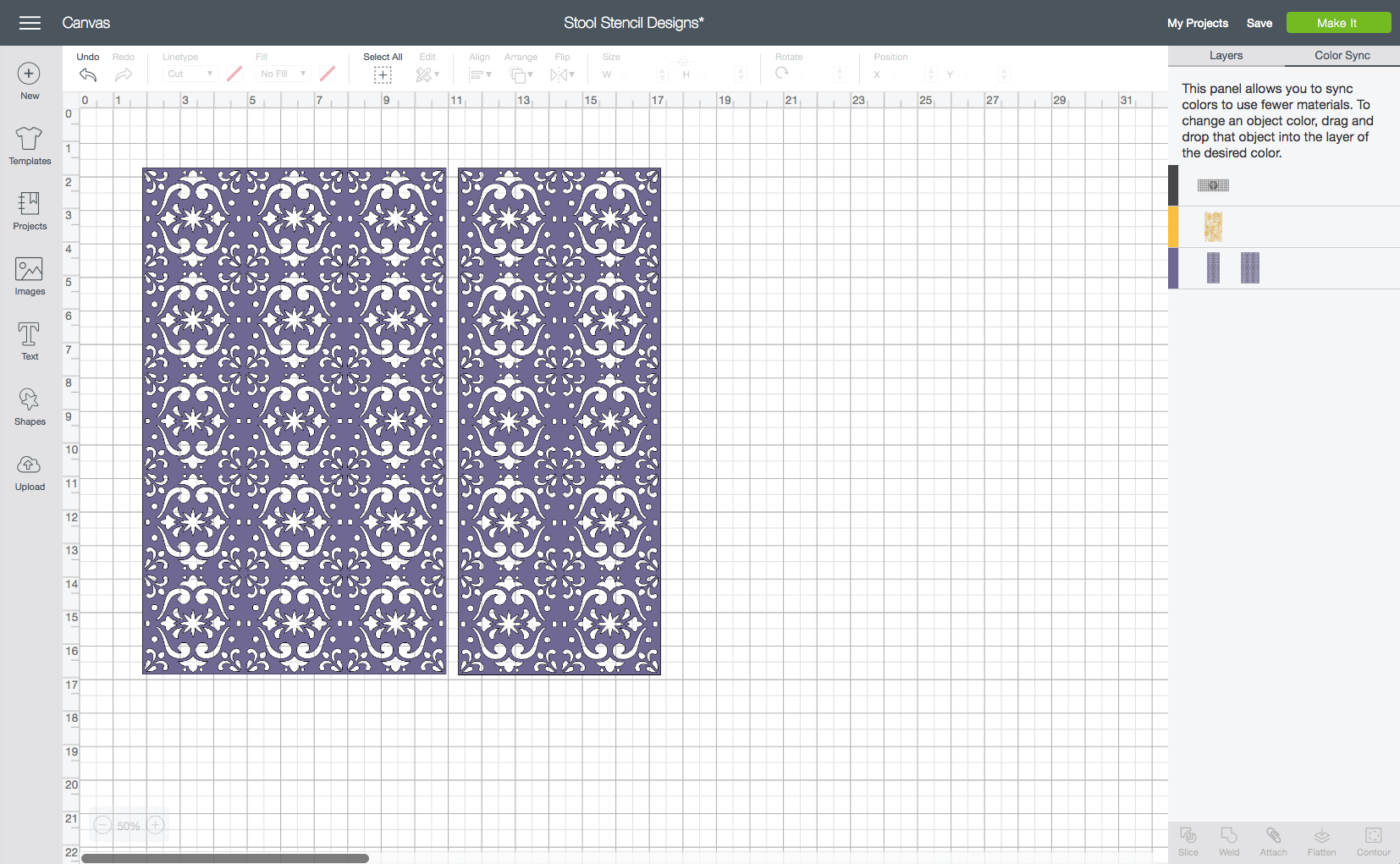
Step 2 – Cut the Blueprint from Stencil Vinyl
Once you have your stencil pattern finalized, your next step is to cut it out of Stencil Vinyl. Load the Stencil Vinyl onto a Standard Grip Mat, and cut out the design with your Cricut set to "Stencil Vinyl."
NOTE: If you are using a Cricut Explore Air, set your dial to "Custom" and then cull Stencil Vinyl from the driblet-down carte.
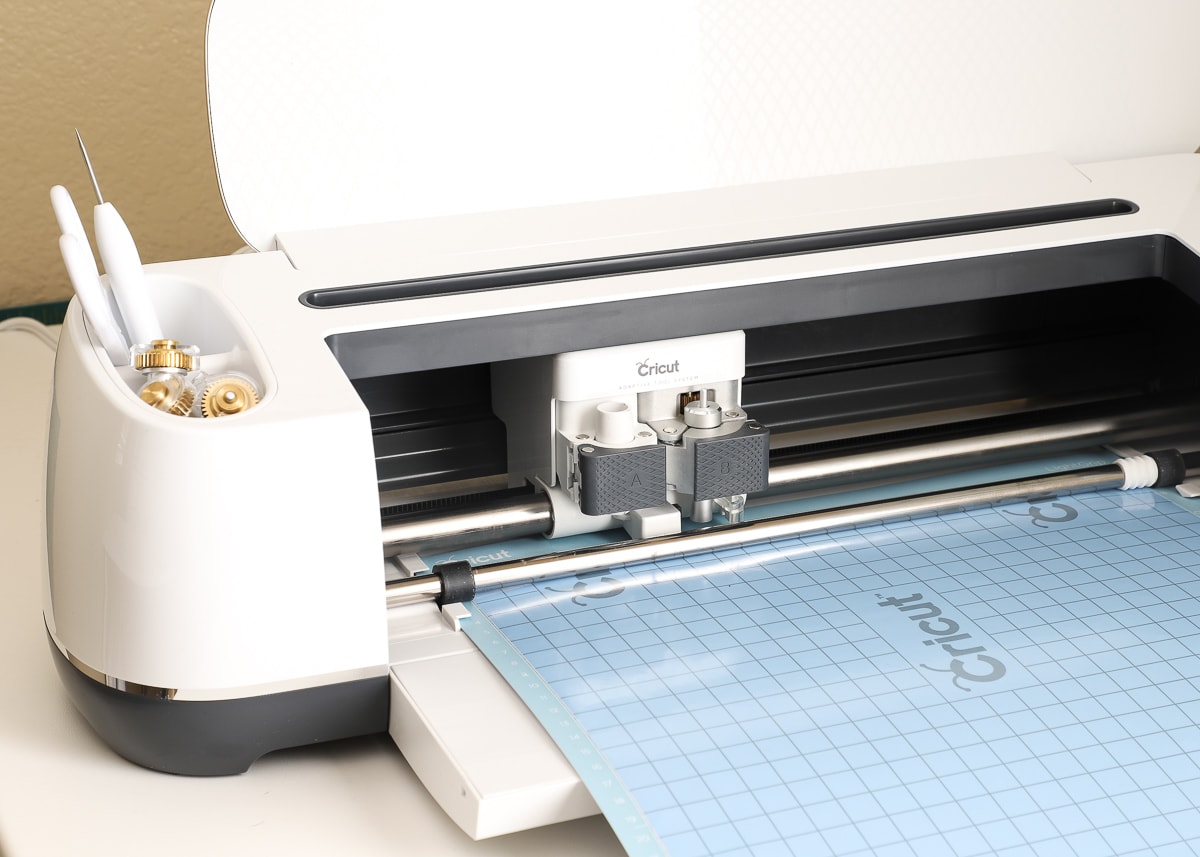
Step three – "Weed" the Stencil Vinyl
With your design cutting out, it's fourth dimension to remove the Stencil Vinyl design from the white paper backing.
When working with traditional vinyl, I always recommend weeding first (the process by which yous remove all the unwanted parts of your pattern) and then using transfer tape to move the vinyl design to your project. (Run into More: How to Cutting Vinyl with a Cricut)
But hither is the wonderful affair about Stencil Vinyl: y'all (usually) don't demand to weed or use transfer paper! Cricut's Stencil Vinyl is sturdy plenty that y'all tin can (carefully) peel information technology correct off the newspaper backing, and all the unwanted elements of your design will remain behind.
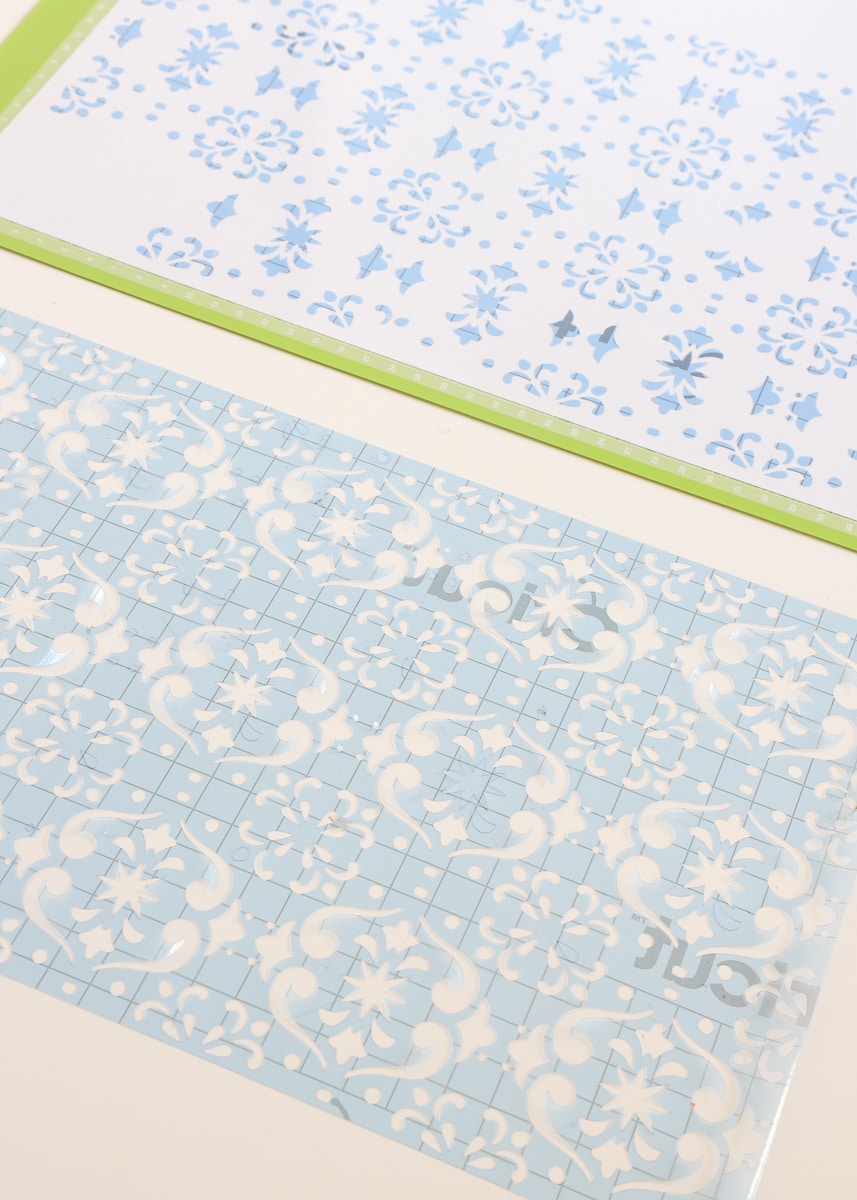
TIP! In the event a few unwanted elements remain continued to your stencil (as seen above), you can easily punch them correct out with your finger or a weeding tool.
Step 4 – Place Stencil Vinyl Onto Project
With your stencil pulled upwardly from the paper backing, place it onto your project with the viscid side downwardly.
If you've worked with traditional vinyl and the idea of placing vinyl by hand makes you lot anxious, don't fret! Cricut Stencil Vinyl lays down beautifully without bumps and wrinkles. And in the event you don't similar the placement or you practice take a wrinkle, but peel it up and place it down again (your design won't warp or tear…I hope!)
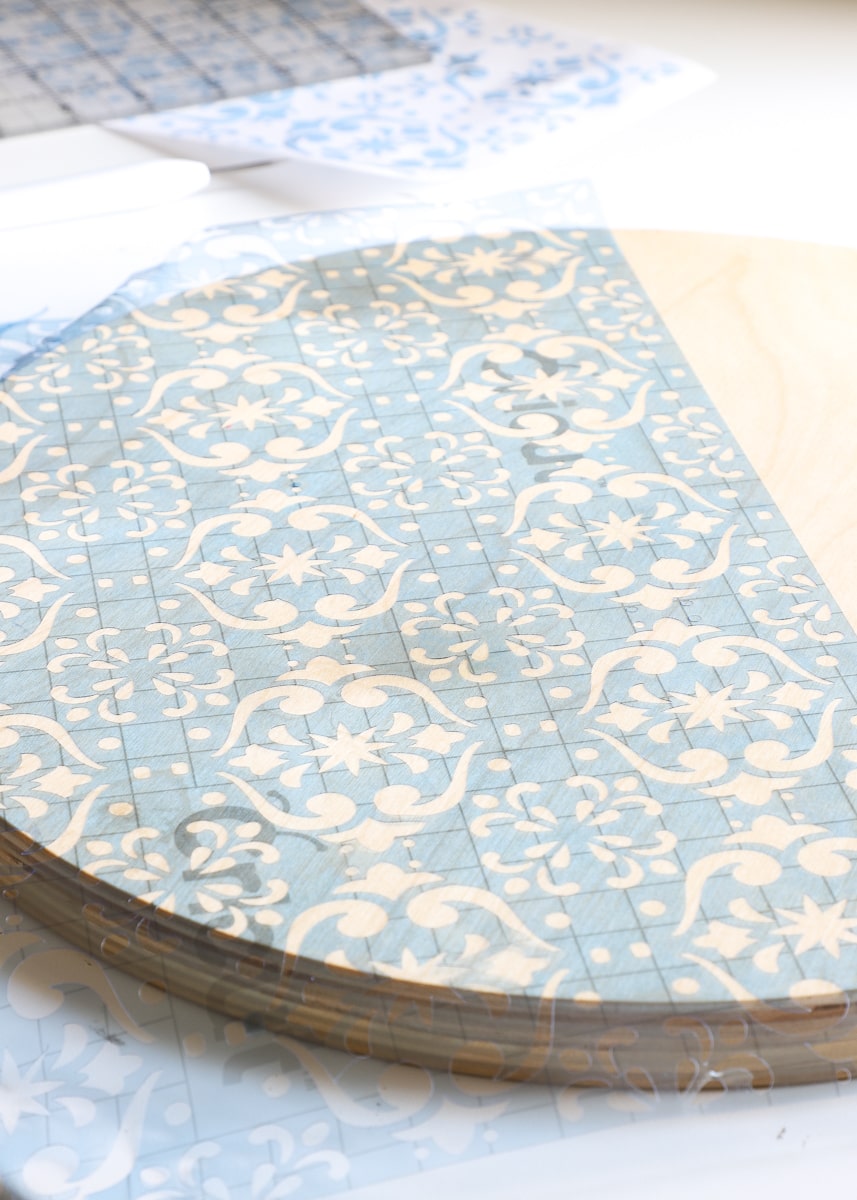
Although the adhesive on the dorsum of the Stencil Vinyl is pretty tacky, I recommend taking the fourth dimension to reeeeaaally secure it to your surface to minimize seeping around the edges of your design. My trusty craft brayer worked perfectly for this, just you lot can as well use your fingers or a Cricut scraper. Practise your best to ensure the Stencil Vinyl is laying flat and there are no puckers or bubbling.
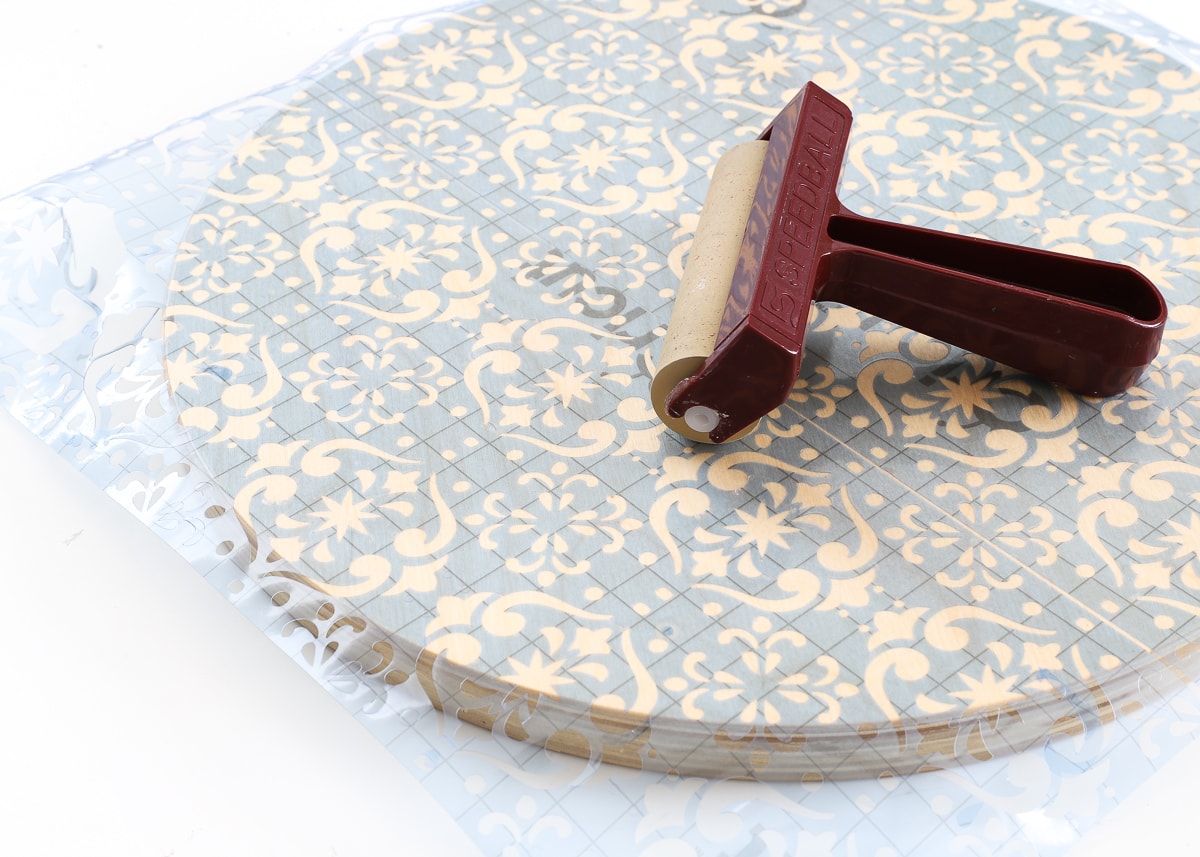
Step v – Paint or Stain Blueprint
Next, it's fourth dimension to paint or stain your design! Here, you'll desire to go on basic stenciling techniques in heed:
- Use as little paint as possible. It's meliorate to do three calorie-free coats than 1 thick coat.
- Sponges and stencil brushes work better than paint brushes (do as I say, not as I do…since I clearly used a castor on this projection!)
- Add together paint in a direct-down movement (like dabbing with a sponge) rather than sweeping information technology side to side (every bit it will most probable seep nether edges).
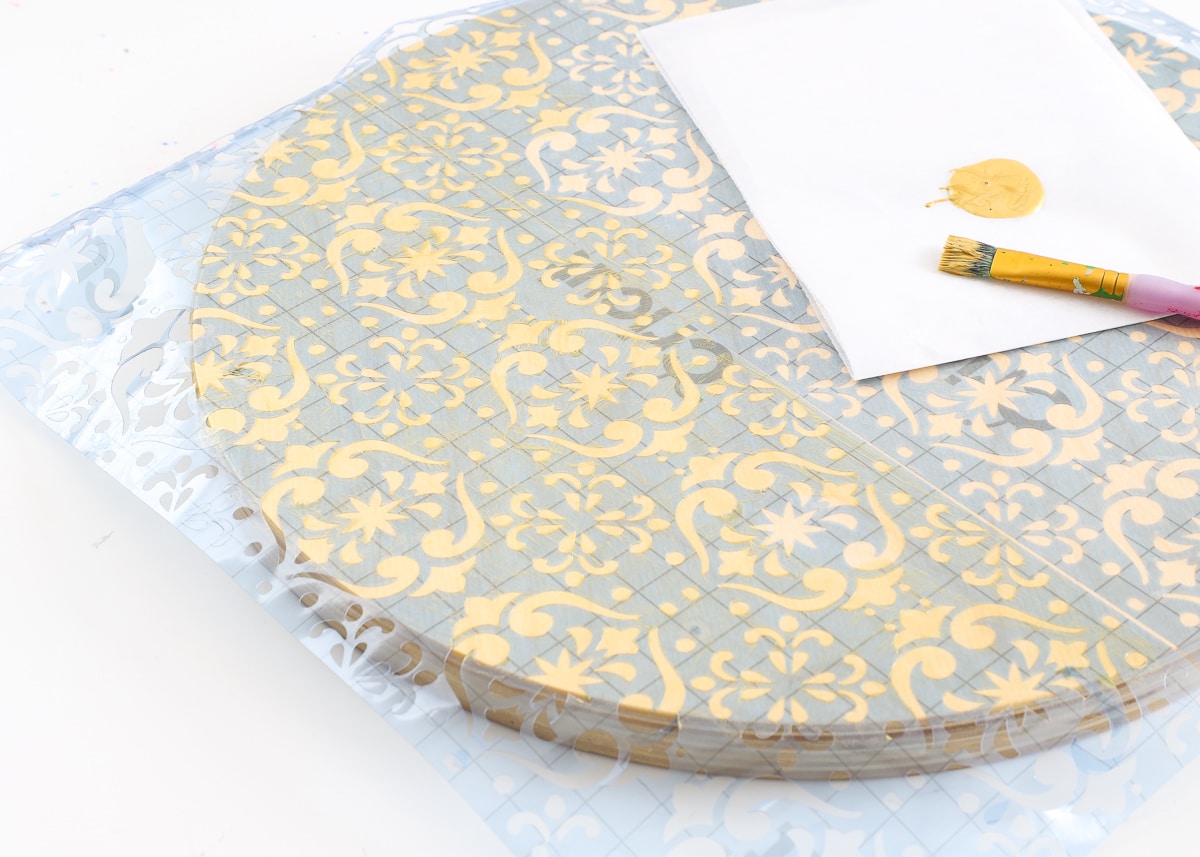
Step 6 – Remove Stencil & Repeat
When yous are satisfied with your pigment/stain coverage, become ahead and remove the stencil (this is the most exciting office!) to reveal your design.
A few things to go along in mind here:
- Be certain y'all accept everything painted/coated to your satisfaction Earlier y'all remove the stencil because you volition never be able to re-place the stencil in the verbal aforementioned spot one time you lot remove it.
- Whether you remove the stencil while the paint is wet or dry is really upwards to you. Even so, if you're going to use the stencil again (either on a new surface or to continue a blueprint), I recommend letting the stencil fully dry earlier using it again so you don't risk conveying wet paint over to the fresh surface. If you're doing a big stencil project (like a floor or wall), consider cutting several identical stencils so you can proceed working while the other(s) dry.
- If your stencil rips and y'all demand to go along using information technology, no worries. Simply cutting another one from more Stencil Vinyl.
- Information technology's pretty difficult to "fix" stenciled designs…once the paint is on, you're generally stuck with it (which is the principal reason stenciling tin can be a bit stressful). Although you may be able to remove small-scale amounts of paint with paint thinner or fifty-fifty chipping it off one time it's dry, the just way to fix big mistakes or really bad bleeding is to sand off the design and get-go over. This is why information technology's REALLY of import to utilize every bit little paint every bit possible when stenciling!
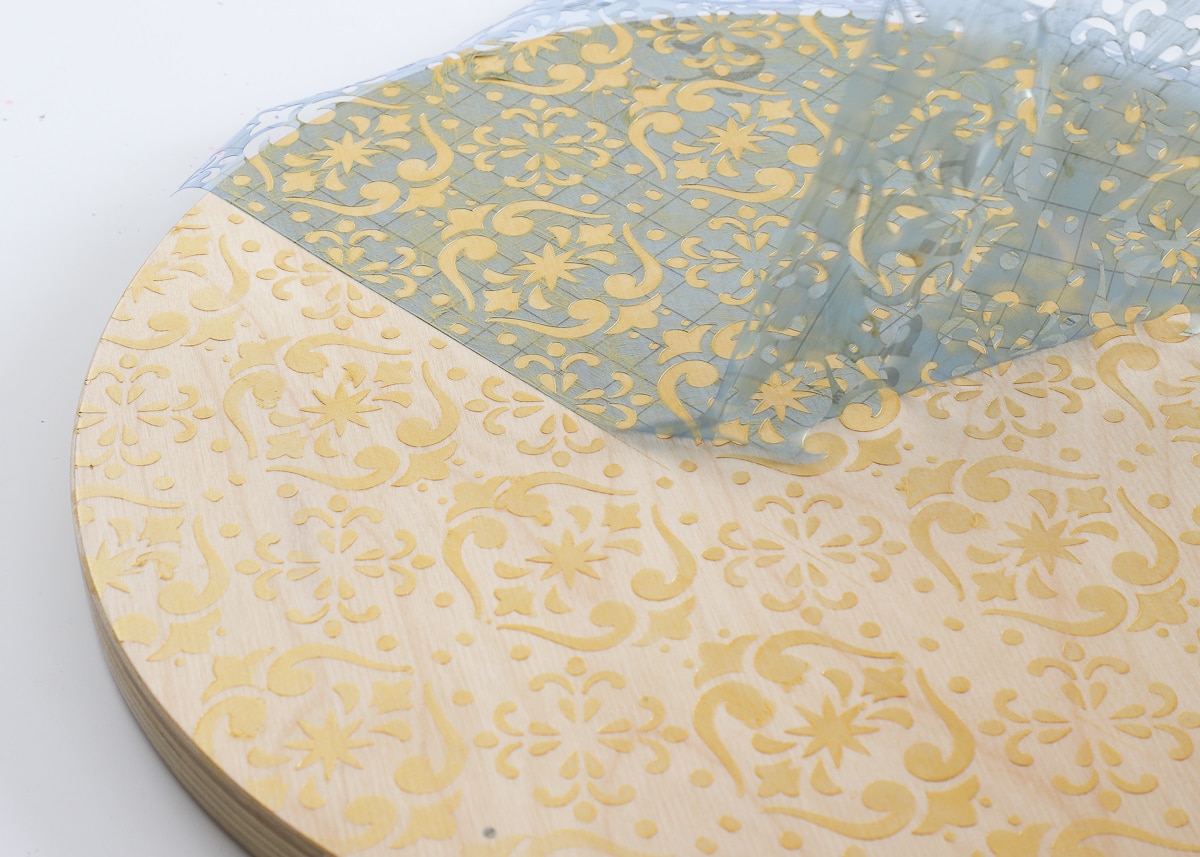
With your design complete, you lot tin use a clear coat as desired or telephone call your project done!
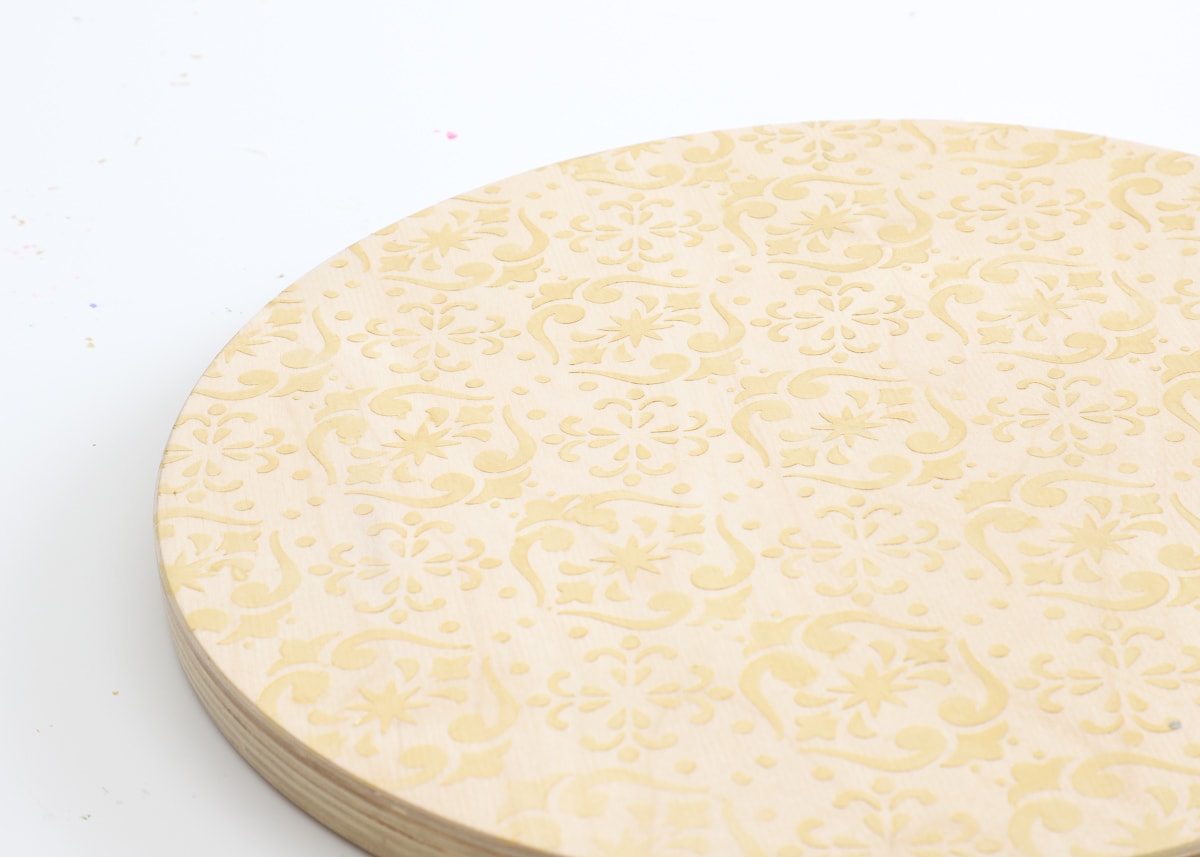
FAQs
At present that you lot understand the basic process of stenciling a project with a Cricut machine, let me dive into some nitty-gritty questions related to Stencil Vinyl and stenciling designs!
And then You Never Have to Weed Stencil Vinyl?
Actually…information technology depends. Equally I mentioned before, Stencil Vinyl is stronger and thicker than your typical crafting vinyl. As such, it tends to pull up really, really nicely from the paper bankroll without warping or ripping. I take found that really uncomplicated patterns and designs (no curvy edges, no teeny, tiny details, etc) tin can exist pulled correct up without any weeding. In the instance below, I was able to pull off my grid stencil, perfectly, without weeding first!

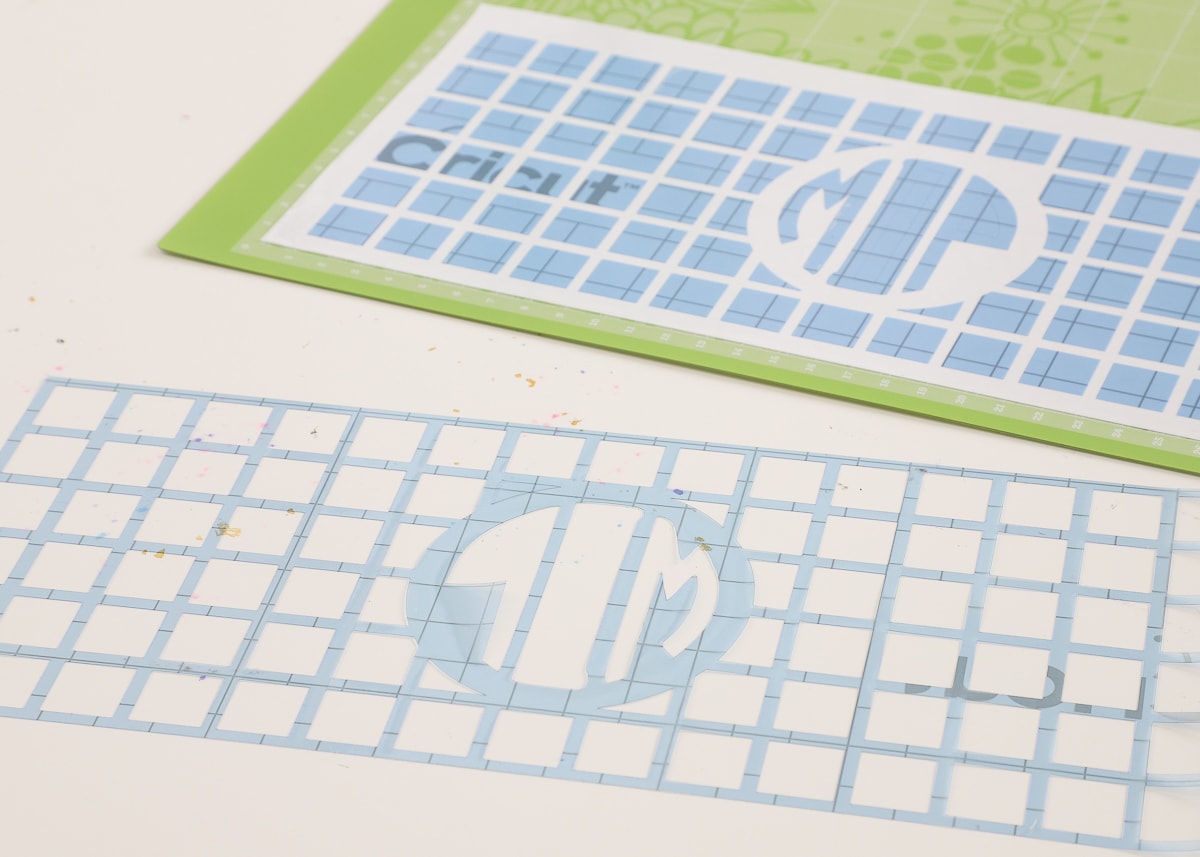
On the other hand, when I first tried to elevator upward this intricate design (below) without weeding, all the lilliputian petal pieces came right upward with the outline. Additionally, the pattern was so irregular and "loose," that it was ripping and warping as I tried to wiggle it all free. As such, weeding this complex design showtime was worth the time in order to keep my design perfectly intact.
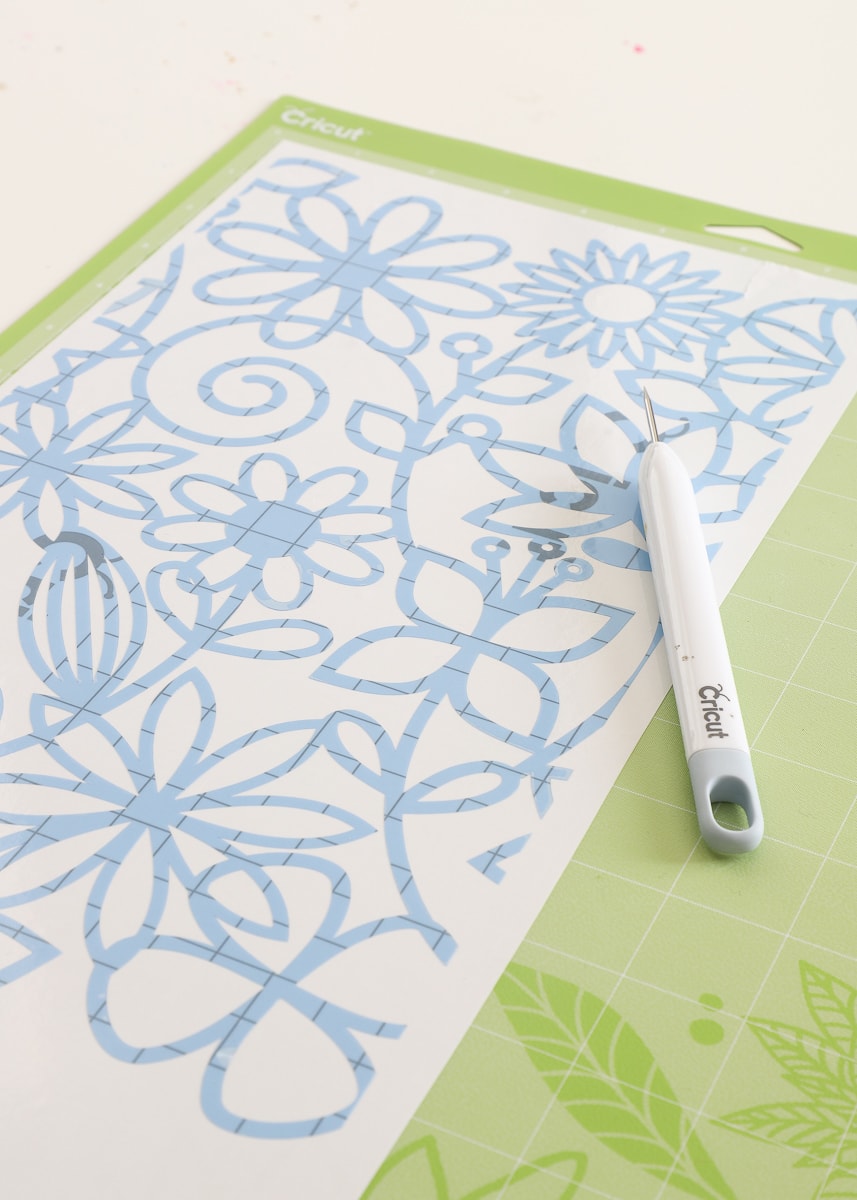
Do You Always Have to Utilise Transfer Paper with Stencil Vinyl?
In most cases, no, you do not demand to use transfer paper with Stencil Vinyl. It is stiff enough, every bit I've shown, to transfer nicely from the paper backing to your project without warping or trigger-happy. This is especially true with unproblematic, sturdy designs where at that place are no loose, flowing, or tiny details.
Even in the case when you need to add together back in non-connected elements (similar the middle of the letters, below), you tin simply identify these past hand. Just utilize the printed gridlines on the Stencil Vinyl itself to help y'all line them up merely right.
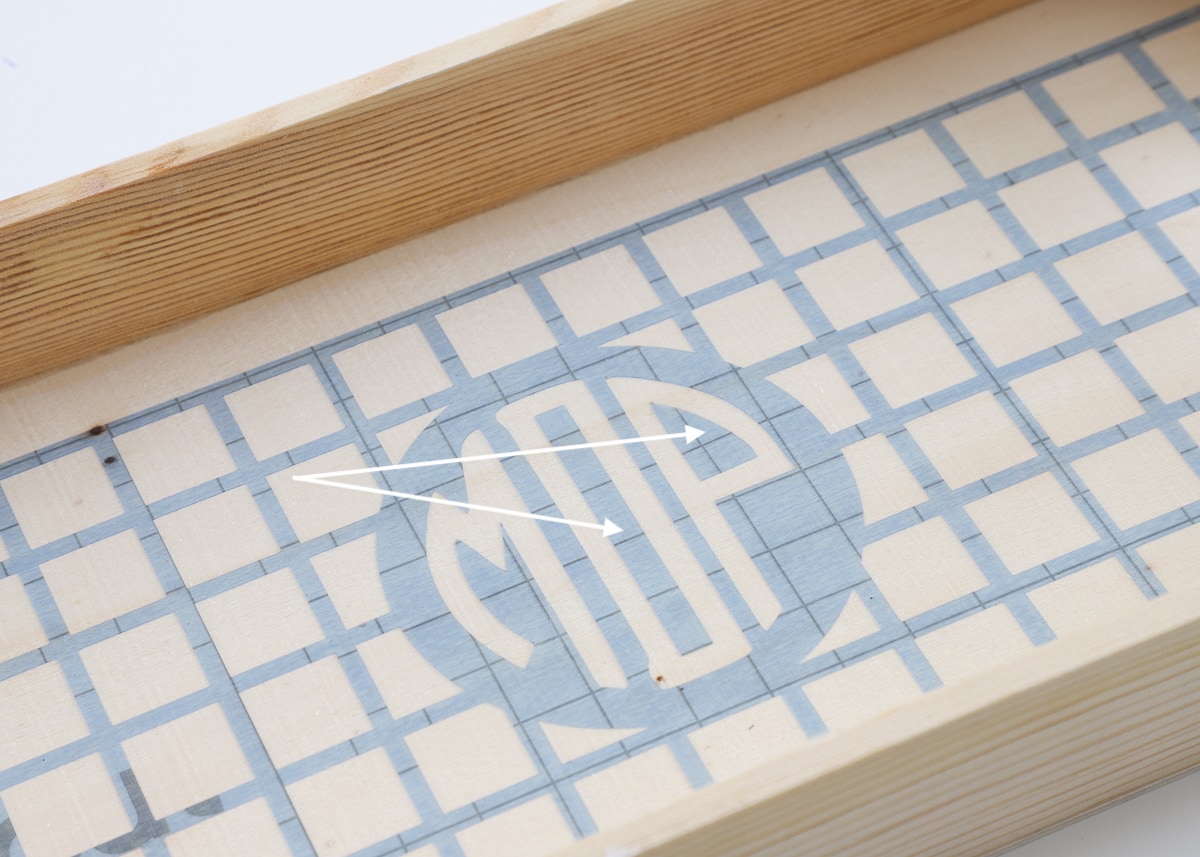
However, you may find yourself wanting to stencil a design that is simply a bit too whimsical to transfer on its own. When I showtime tried to transfer the very loose flower pattern (with lots of non-connected elements) by paw, getting each and every part of the design to lay downward squeamish and smooth proved incommunicable. So I re-cut the design and transferred it to my project with transfer paper instead. (Learn: How to Apply Transfer Record with Vinyl)
NOTE: Getting transfer paper to "permit go" of Stencil Vinyl is a little trickier compared to standard vinyl. Work slowly and use a scraper in lodge to become the transfer paper to elevator off while keeping the Stencil Vinyl all the same on the project.

Can the Stencil Exist Used Over and Over Again?
Yes! Even after you paint over your stencil and (carefully) pull it off, you will most probable exist able to lay information technology down onto another surface and use it again.
Eventually y'all might find that the agglutinative backing isn't as tight equally it was at the first and/or is assuasive too much pigment under the edges. At this point (or if your stencil rips), it's time to cut a fresh stencil and continue going!
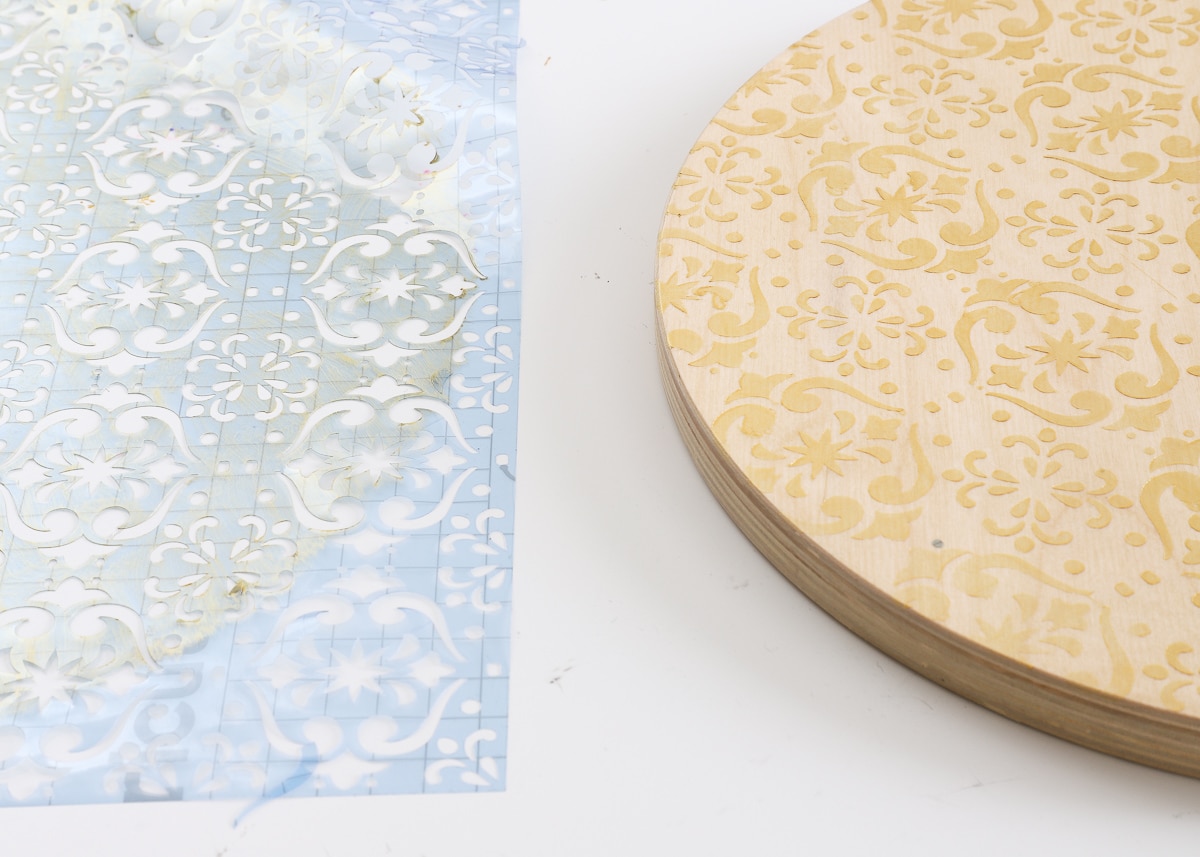
What Makes a Adept Stencil Design?
This one is kind of a doozy and I could probably write a whole separate post on information technology, only I want to cover some nuances of stencil design here.
First, when looking for good designs to cut into stencils, I recommend searching "Pattern" in the Cricut Design Space Paradigm Library. This will yield all sorts of patterns that will make awesome stencils! The Edge to Edge Image Sets are my favorite! Virtually all of them can be created into larger stencils via the Weld Tool.
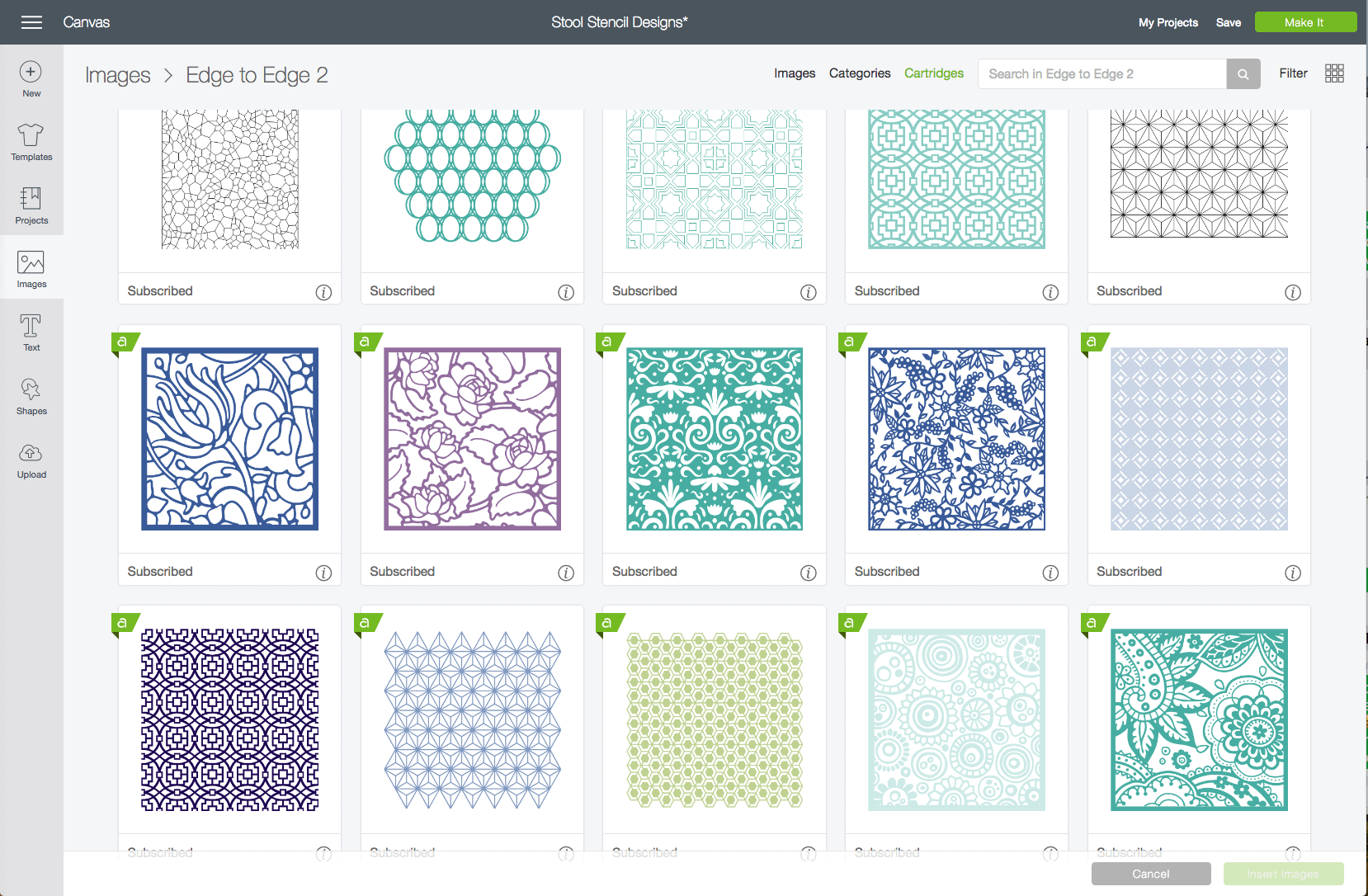
Side by side, let'southward conversation about the concept of the POSITIVE and NEGATIVE aspects of a design:
- The POSITIVE attribute(south) of the design:
- Are the line(s) that brand upwards the pattern as you see information technology
- This is unremarkably the part of the pattern yous keep/apply for your project
- The NEGATIVE aspect(due south) of the pattern:
- Are the white space(south) that exist between/within the POSITIVE aspects of the design
- These are usually the parts of the design that yous want to remove (via weeding) or discard when assembling your projects.
Whenever yous cut ANY design, at that place is ever POSITIVE and NEGATIVE space and yous can decide which to employ for your stencil project.
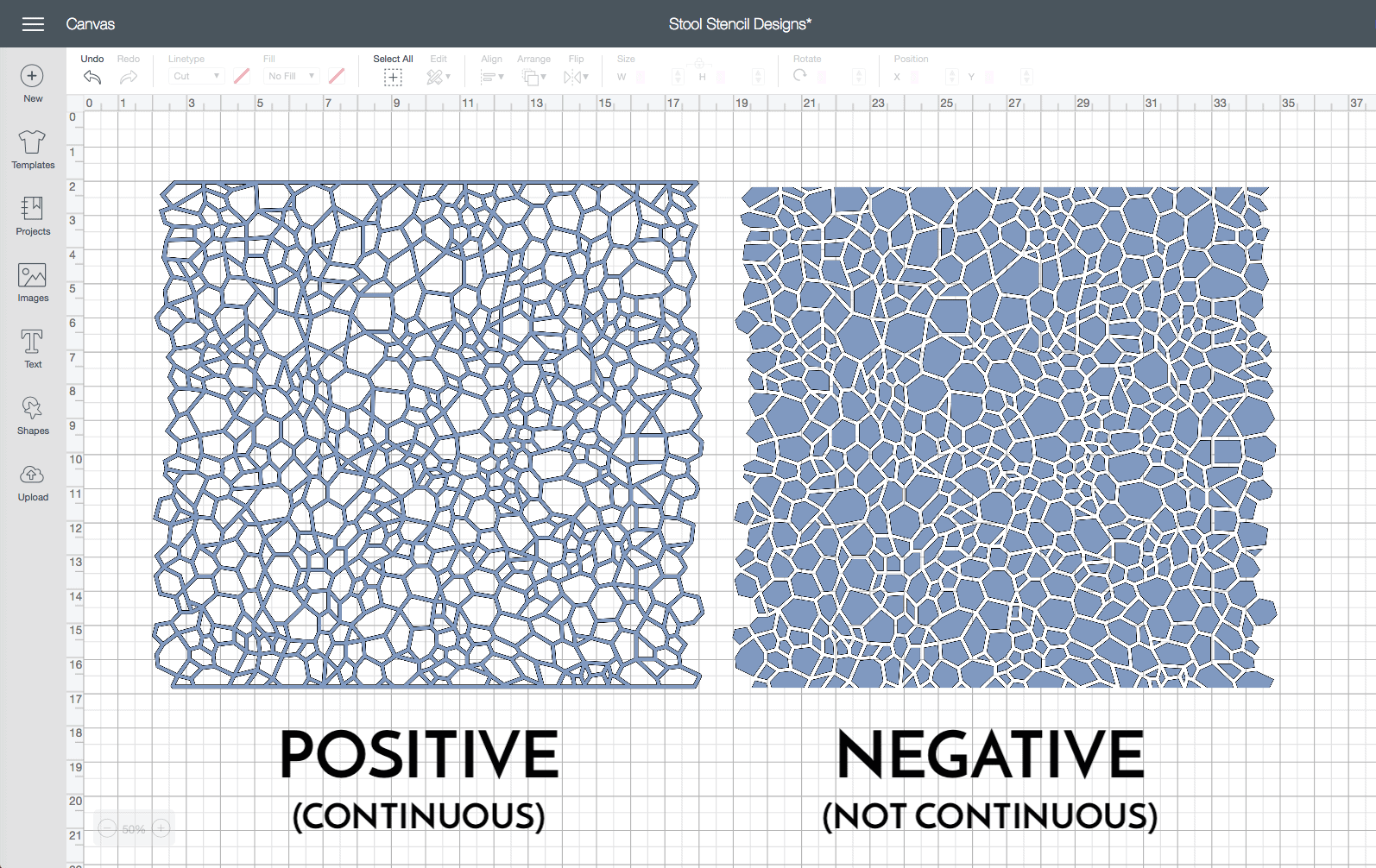
When it comes to selecting a "good" pattern to cutting into a stencil, it is easiest if the POSITIVE attribute of the blueprint is one, continuous piece (to a higher place/below left). This not only means you will exist able to apply your stencil in one pace without transfer paper, simply it likewise ways it will exist removable and reusable.
If your stencil design is instead made upward of non-continuous pieces (to a higher place/below right), you volition HAVE to use transfer paper to lay it down, and information technology will be a one-time use stencil since you will have to remove each element individually.
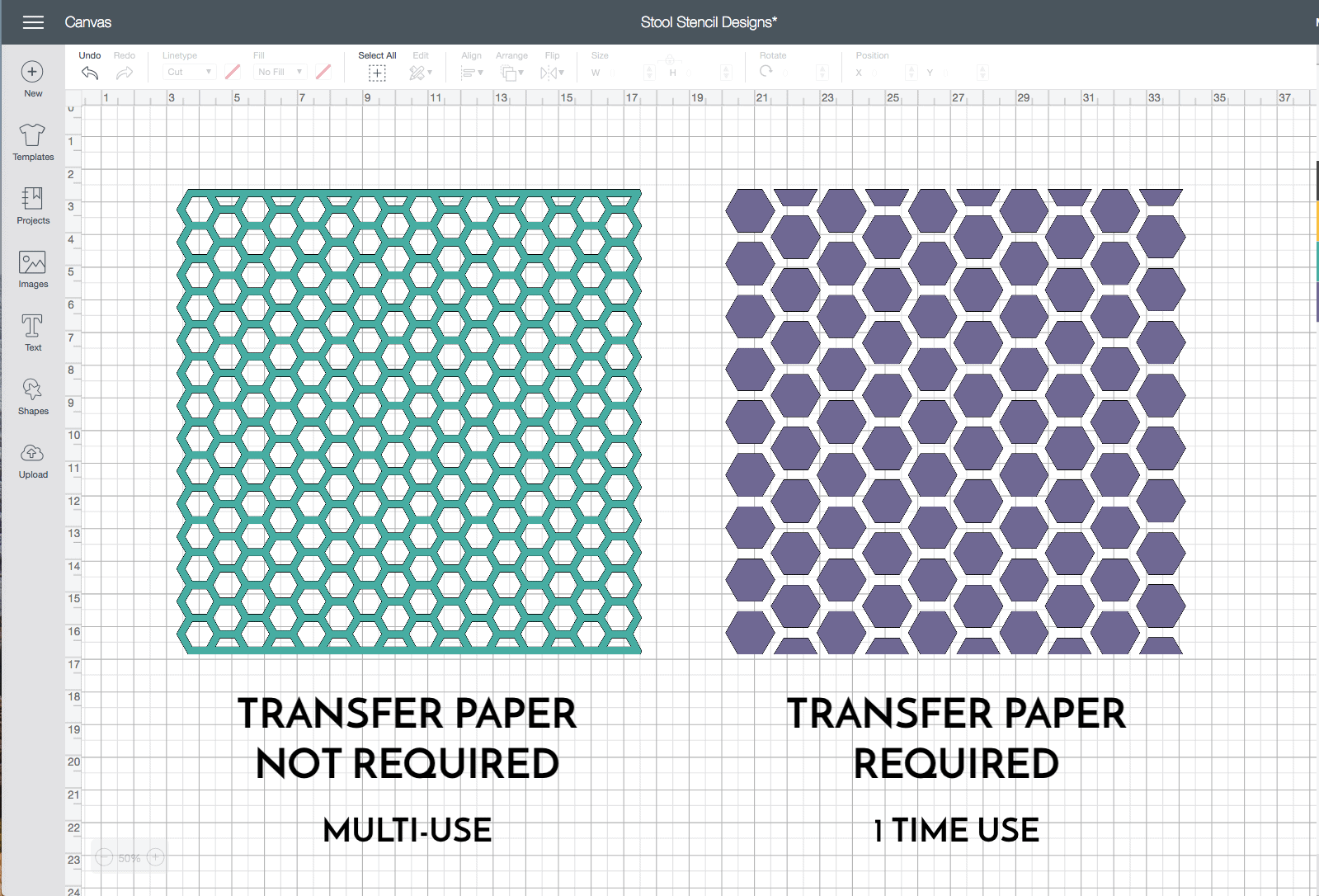
Although a continuous blueprint is not absolutely necessary for a stencil, information technology'due south always my preference since the entire design is one solid unit. Hither are some other examples of continuous designs that would make for nifty stencils!
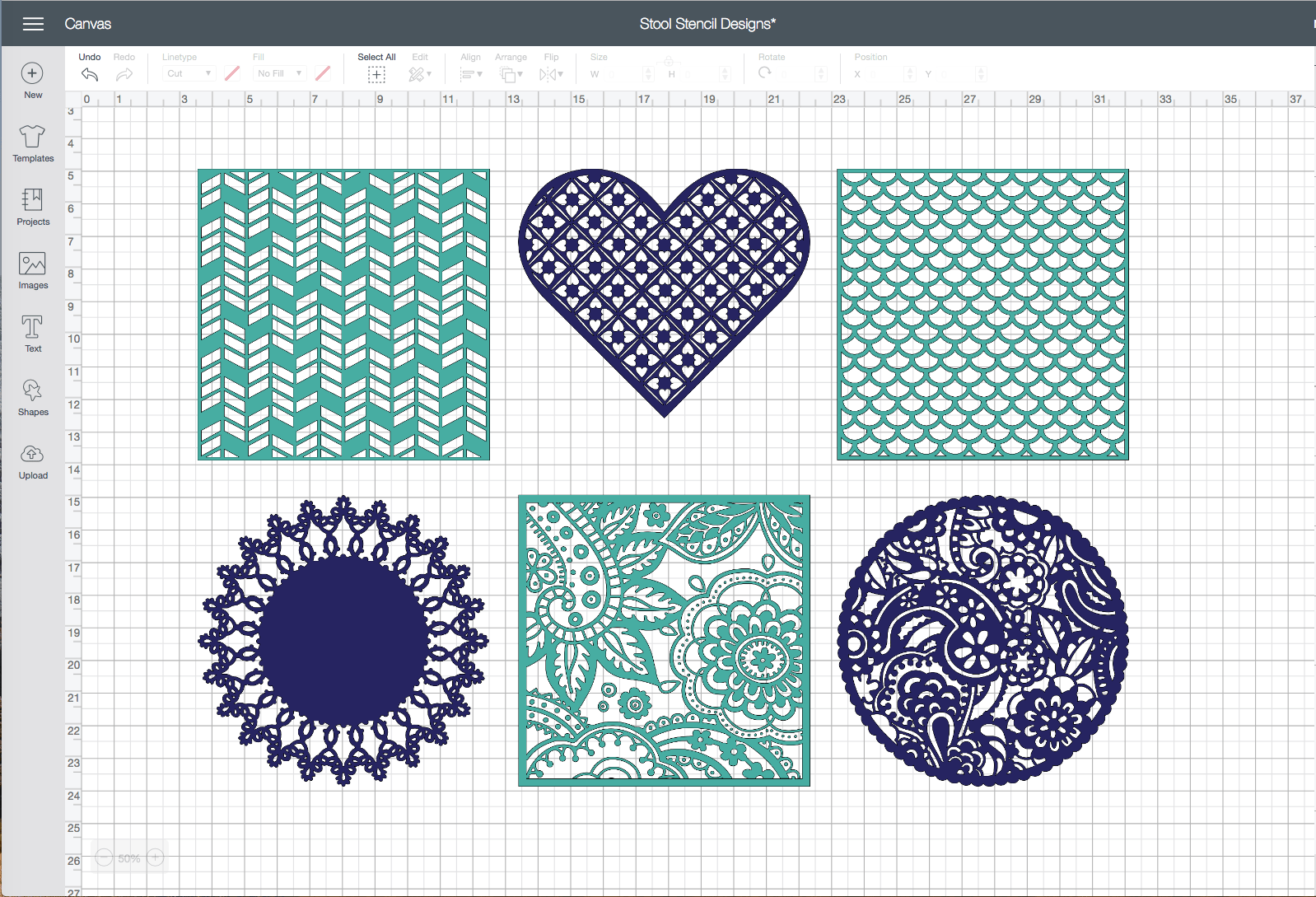
Finally, the concluding thing you lot need to call up nigh when you are creating your stencils is how information technology will look once painted. Remember, the stencil design itself (the POSITIVE aspect of the design) serves equally a mask, and it's the NEGATIVE parts of the design that receive the paint. Therefore, you demand to visualize how each design volition await in reverse once painted.
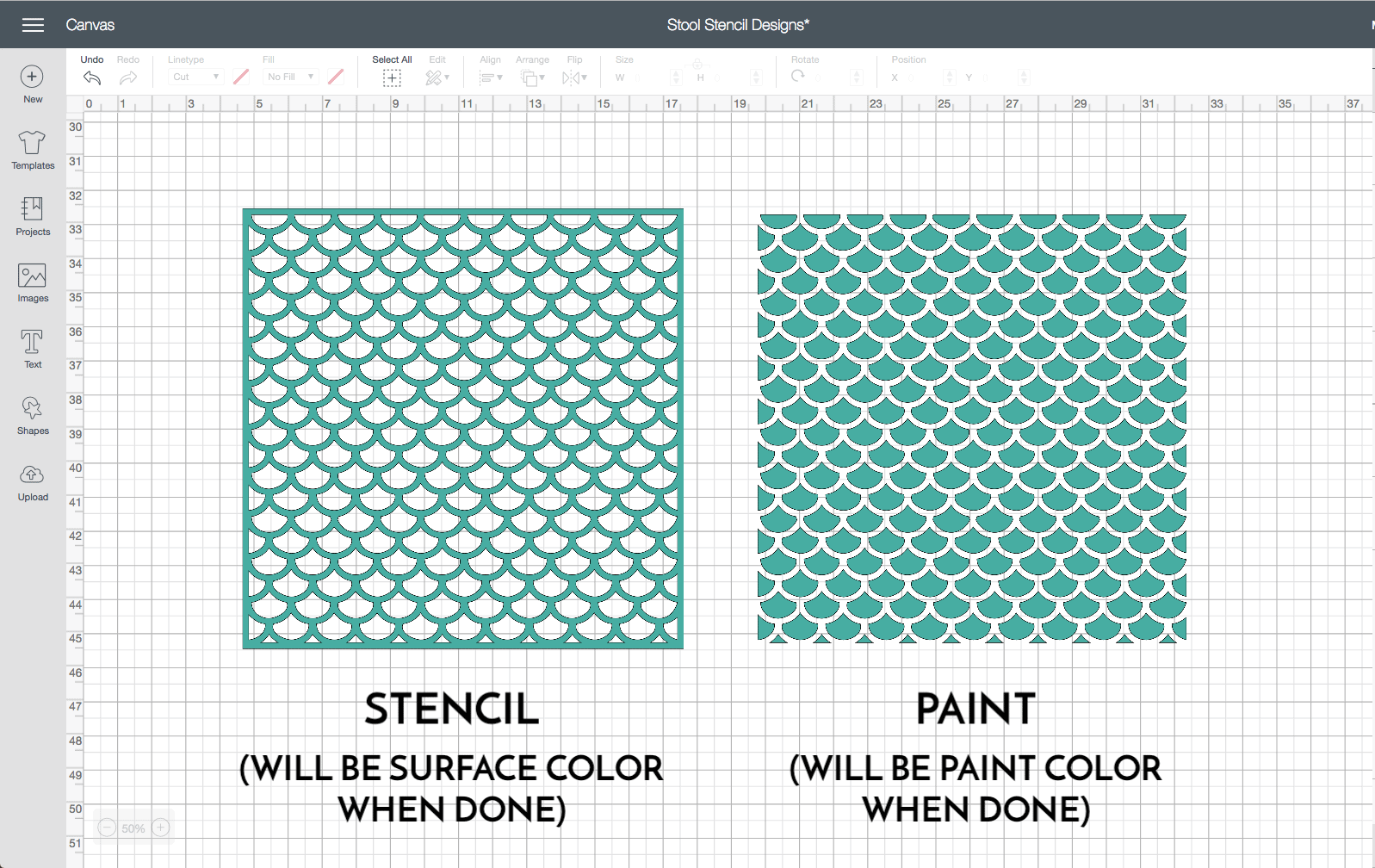
In the instance above, if you employ the lefthand blueprint as your stencil, your object will be more often than not painted with green scallops (as shown on the correct). Should yous desire the scallop outlines green instead (as shown on the left), you volition demand to use the right-mitt design as your stencil (via transfer paper).
I know…it tin be a little fleck of a mind game equally you design your project. but information technology's of import to remember this all through and then your projects turns out but the way you desire them!
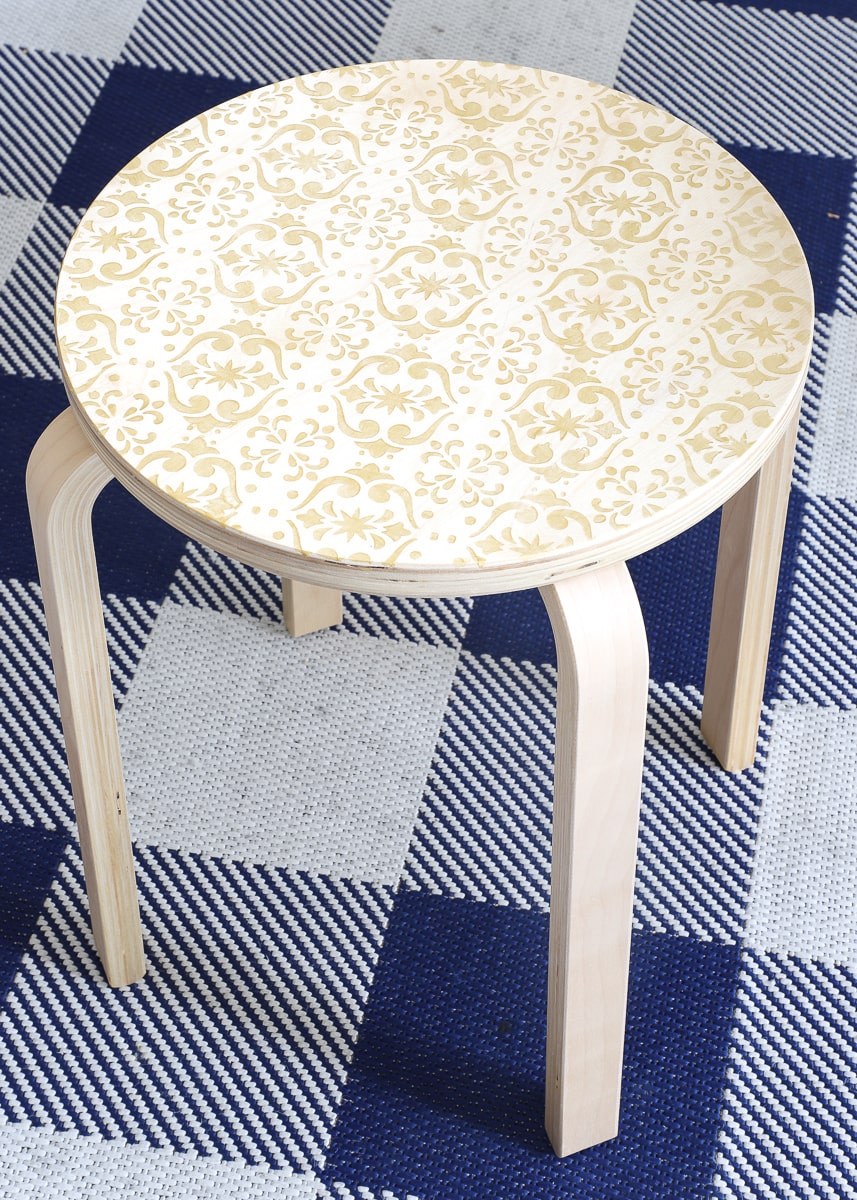
Phew! I know this tutorial was a doozy…well done making information technology through!
Although cut stencils with a Cricut auto is actually pretty piece of cake (I promise!), at that place are lots of things to consider in order for your projects plough out just right. I hope this comprehensive overview gives y'all the confidence to try a stencil project; and if there'south annihilation that is unclear or comes upwardly while you're working with Stencil Vinyl, don't hesitate to let me know and I'll help you out the best I tin!
Run across You lot Soon!
Megan
How To Use Cricut Stencil Vinyl,
Source: https://thehomesihavemade.com/how-to-cut-stencils-with-a-cricut/
Posted by: hutchinsonloulty.blogspot.com


0 Response to "How To Use Cricut Stencil Vinyl"
Post a Comment